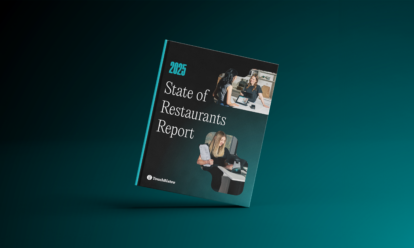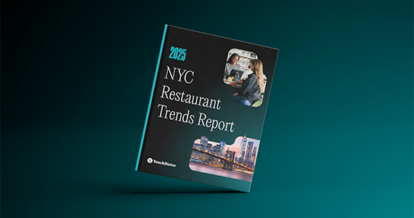Since March of 2020, restaurants across the country have been largely closed to the public in an effort to slow the spread of COVID-19. Even as some restaurants have reopened their doors for takeout and delivery, dining rooms have sat empty as owners anxiously wait for the green light to reopen their full service operations.
But just as quickly as those dining room closures came into effect, the same restrictions are slowly being lifted across North America. In states like Alaska, Georgia, Texas, and Tennessee, the local economy is ramping back up and restaurateurs are beginning to open their dining rooms up to the public.
Of course, this doesn’t mean it’s back to business as usual for restaurants. Rather, the gradual lifting of dining restrictions is ushering in a new normal in which public health is prioritized above all else – even a world-class dining experience. This means that just about every restaurateur needs to have a plan in place to prepare for this new era of hospitality.
To help you create a plan for your own restaurant opening, we’ve created a comprehensive guide of 10 steps to reopening a restaurant, including:
- Understanding your local restrictions
- Preparing for staffing adjustments
- How to establish food safety best practices
- Implementing personal hygiene protocols
- Implementing physical distancing measures
- Creating a new floor plan
- Communicating with vendors
- Using technology to navigate dine-in restrictions
- How to communicate with customers
- Maintaining your current takeout and delivery business model
Though not every restaurateur will choose to reopen when local dining restrictions are lifted, this information can help you prepare for the day that it makes sense for you to open your business back up.
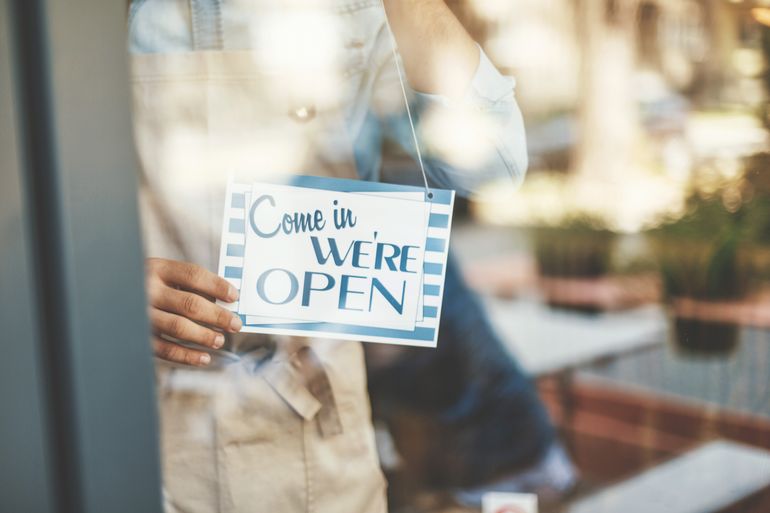
1) Understand Your Local Restrictions
Before you can even begin creating a plan for your restaurant opening, you need to understand your local restrictions inside and out. At the federal level in the U.S., the White House has created an “Opening Up America” initiative that outlines the different stages for reopening restaurants across the country. However, the reopening is intended to be staggered, and individual states and counties are left to determine their own dining restrictions.
While there’s no one-size-fits-all plan for reopening restaurants, most of the new restrictions revolve around issues such as capacity and physical distancing. With that in mind, there are some best practices that all restaurateurs should keep in mind when planning for reopening.
Capacity
One of the biggest considerations for any restaurant reopening is capacity. This refers to limits on how full a dining room can be. For instance, restaurants in Tennessee can’t exceed 50% of their maximum occupancy, while in places like Texas and Alaska, restaurants are limited to just 25% capacity. For small restaurants with just a handful of tables to begin with, operating at a limited capacity may not be feasible. For restaurants that have a significant number of tables in their dining rooms, it’s important to do the math and determine whether limited capacity dining can generate more revenue than takeout and delivery. If the answer is no, it might be worth keeping your dining room closed until capacity restrictions are lifted.
Physical Distancing
By now, most people are familiar with the physical distancing rules of maintaining at least six feet from one another at all times. And even as restaurants reopen, this rule remains the gold standard.
However, keeping customers six feet apart may mean rearranging or even removing tables from your floor plan to give guests enough space to move around safely. This could also mean making use of a restaurant patio or other outdoor space where it may be easier to separate tables.
Keep in mind that physical distancing measures will also apply to your staff. Think about how you can space out cooking stations to help staff maintain distance from one another. If your kitchen is on the smaller side, this may mean significantly limiting the number of staff working in the kitchen.
Other Safety Measures
While physical distancing measures and limits on capacity are to be expected, there are some not-so-obvious rules that restaurants should prepare to accommodate – especially when it comes to food safety and personal hygiene.
For instance, restaurants in Texas have been asked to provide hand sanitizing stations for guests, use disposable menus, and serve condiments in single-serve portions. In Alaska, tables and chairs must be fully sanitized after each seating, while high-touch areas such as POS screens must be sanitized every hour.
Beyond new serving practices, restaurant staff will also need to take extra precautions. For example, in Tennessee, all staff must have their temperature taken prior to their shift, and are required to wear gloves and face masks while working – a rule that means you’ll need to provide personal protective equipment (PPE) for your team.
It’s clear that the rules and restrictions for reopening vary from one location to the next, and restaurants should be prepared to make significant changes to their day-to-day operations. To find the specific rules and regulations for your state, you can consult the National Restaurant Association’s COVID-19 State Action Center.
2) Prepare for Staffing Adjustments
Despite the laundry list of new rules, one of the positives of a restaurant reopening is the opportunity to bring back staff that may have been furloughed or laid off.
However, restaffing your restaurant may not be as simple as calling up all of your old employees. Some employees may have found other work, while some may be unable or unwilling to return to work immediately. With this in mind, one of the first steps to reopen a restaurant should be setting aside enough time to contact past employees and, if necessary, implement a contactless hiring strategy to bring on new ones.
3) Establish Food Safety Best Practices
For restaurants, food safety has always been a top priority. But while you may have received rave reviews from the health inspector in the past, the COVID-19 pandemic has given new meaning to the concept of food safety. Now more than ever, you need to ensure that your food is prepared and served in a safe environment.
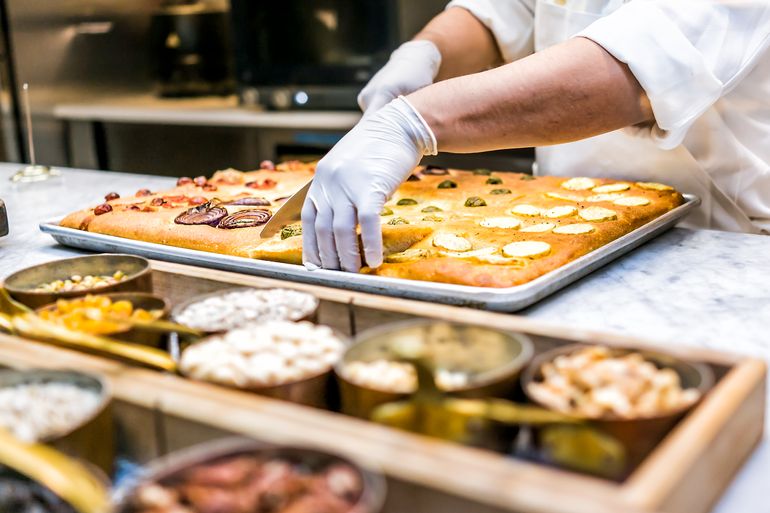
For the Dining Room
When it comes to keeping your dining room safe and sanitary, prepare to implement the following best practices:
- Only serve condiments upon request and in single-use portions (e.g. a side of ketchup instead of a bottle on the table).
- Remove garnishes (e.g. lemons and limes) and unwrapped straws from drink stations.
- Provide silverware wrapped or covered at the table, along with glasses turned upside down on a clean napkin.
- Use disposable napkins and tablecloths wherever possible.
- If salad bars and buffets are permitted, sneeze guards should be in place.
For the Kitchen
One of the most important steps to reopening a restaurant is building on established food safety practices to address the specific concerns related to the spread of COVID-19.
According to the National Restaurant Association, some of these extra precautions should include:
- Deep clean your entire facility, especially if your restaurant has been closed.
- Disinfect high-touch surfaces frequently using an EPA-registered disinfectant.
- Disinfect all hard, non-porous surfaces, and high touch points prior to opening and on a routine schedule after opening.
- Avoid all food contact surfaces when using disinfectants.
- Ensure all hot and cold holding equipment is functioning properly.
- Clean restaurant HVAC intakes daily.
- Ensure the dishwasher is working properly and that chemicals are dispensing correctly.
- Discard any food items that are out of date or have spoiled.
- Ensure all food containers, utensils, unprotected tools, and small wares are thoroughly cleaned and sanitized.
- Provide employees with gloves for preparing and handling ready-to-eat foods.
- Wrap food containers to prevent cross-contamination.
- Aprons, towels, work clothing, etc. should be placed in trash bags to be properly laundered. If a professional laundry service is not provided, train employees on properly handling their work clothes at home.
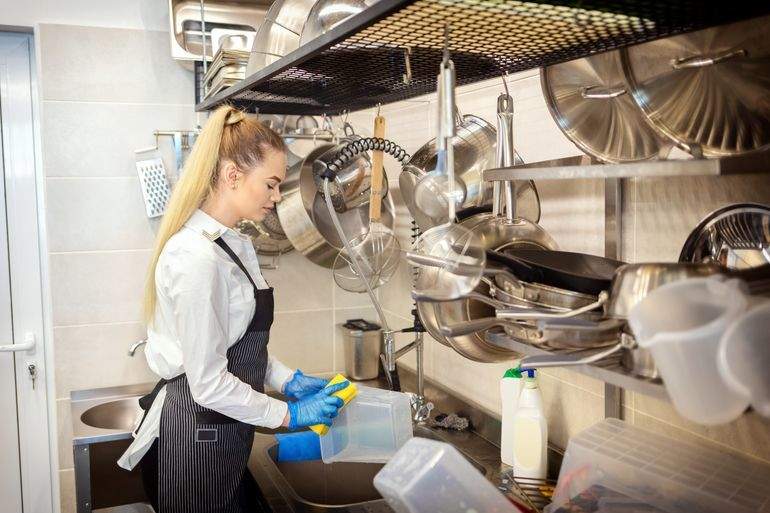
4) Implement Personal Hygiene Protocols
Prior to your restaurant opening, ensure that staff and customers understand the importance of personal hygiene in protecting their own health and the health of those around them.
For Customers
Even for customers who are eager to dine out, personal hygiene will still be a top priority. To assuage fears and make guests comfortable, implement the following best practices:
- Make hand sanitizer readily available to guests or consider a touchless hand sanitizing solution.
- Clean and sanitize your reusable menus after each customer, or use disposable paper menus.
- Between seatings, clean and sanitize any items touched by customers, including digital ordering devices, credit card terminals, etc.
- Thoroughly clean and disinfect restrooms prior to opening and then at least four times per day after opening.
- Encourage customers to use contactless payment options.
For Staff
While staff may be properly trained on food safety, you should also be taking the following precautions when it comes to the health and hygiene of your team:
- Update your illness policy to include fever and respiratory symptoms, and prohibit any sick employees from entering the workplace.
- Carry out wellness checks when employees arrive for their shifts. Though the CDC has not mandated temperature checks for employees, some states and provinces may require this as a screening tool. For restaurants that are taking the temperature of their employees, the person taking temperatures should be provided with proper PPE.
- If an employee becomes ill or presents signs of illness, operators should follow CDC guidelines and instruct the employee to self-isolate.
- Stagger start times to minimize contact during sign-in.
- Implement strict handwashing practices, including how often employees should be washing their hands.
- Though it may not be required, the CDC has recommended wearing face masks to mitigate the risk of infection. If you do ask your employees to wear face masks, ensure they are following the proper guidelines for wearing and caring for their mask.
5) Communicate with Vendors
If you’ve been closed for the duration of the pandemic, your fridges are probably looking a little empty.
While it may be tempting to wait until the last minute to restock your inventory, keep in mind that every other restaurant will be doing the same thing. Instead, start stocking up on shelf-stable supplies in advance, allowing plenty of time to stagger your deliveries. If necessary, re-evaluate supplier contracts and adjust as needed.
6) Implement Physical Distancing Measures
As mentioned above, physical distancing measures aren’t going away anytime soon, which means you’ll need to have a plan to keep your customers (and your staff) six feet apart.
Though the measures you take will depend on local restrictions and the square footage of your restaurant, you should consider the following:
- Limit party size at tables to no more than the established maximums.
- Where practical, implement physical barriers such as partitions between booths or plexiglass barriers at registers and host stands.
- Discourage guests from congregating in waiting areas or bar areas. This may mean creating a process (e.g. floor markings, waiting in cars, etc.) to keep guests separate while waiting to be seated.
- Post highly visible signs or use audio messages to remind guests about social distancing.
- Consider designated entrances and exits to reduce face-to-face exposure.
- Limit contact between wait staff and guests when possible.
- Remind third-party delivery drivers and suppliers to abide by physical distancing requirements.
- Where possible, use technology to reduce person-to-person interaction, such as text on arrival for seating and contactless payment options.
- If you are still offering takeout, set up a designated pick-up area away from your dining area.
- Consider a reservations-only business model or call-ahead seating to better control the flow of diners.
- Where possible, limit your menu offerings or stagger workstations to accommodate cooking and preparation at a distance.
- Limit the number of employees allowed in common areas, such as break rooms and restrooms.
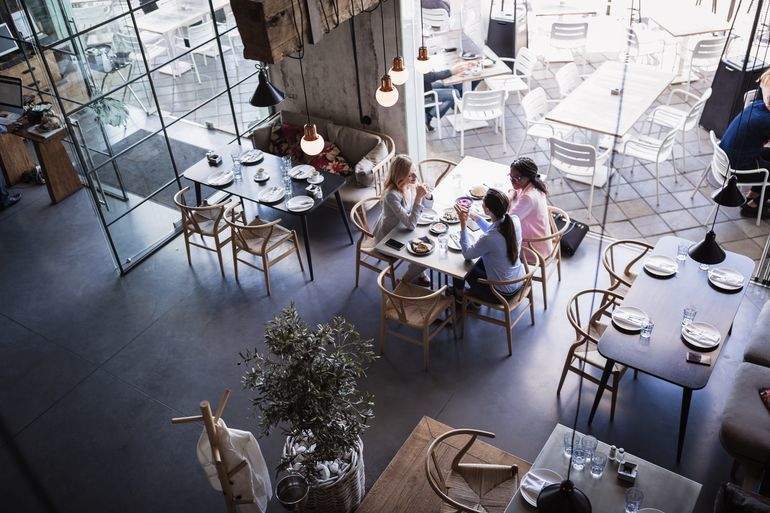
7) Create a New Floor Plan
Part of accommodating physical distancing involves updating your restaurant floor plan. Even if a minimum distance between tables isn’t mandated in your area, leaving a little extra room can make guests feel more at ease.
Beyond simply moving furniture around, consider some of the following strategies for reconfiguring your floor plan:
- Remove bar seating or create a physical barrier between guests and the bar.
- Eliminate tables that seat groups of more than six people.
- If tables cannot be moved, consider signage on every other table or booth explaining that they are unavailable, or consider plexiglass partitions between booths as an alternative.
- Make use of private dining areas for larger tables.
- Use outdoor spaces to maximize available tables.
- If possible, create designated entrances and exits.
Part of streamlining your floor plan can also include upgrading your POS.
If you’re still using a legacy POS, this system is likely taking up a major chunk of your dining room. If there’s room in your budget, consider switching to a smaller, modern POS solution prior to your restaurant opening. Using a modern POS not only frees up more room for staff and customers to move around, but features such as table management software can make it easier to keep track of ongoing changes to your floor plan.
Talk to a POS Expert Today About Switching
8) Consider Technology
We already mentioned having a modern POS in place can help with aspects like floor plan and table management (here’s a list of 33 things a POS can do for you).
But your POS is not the only piece of technology that can make your restaurant reopening a little smoother. With strict limits on capacity, reservations software can be a useful tool in controlling the flow of diners through your restaurant.
A reservations system not only makes it easier to stagger seatings, it can also reduce the number of walk-ins waiting for a free table.
In some cases, states such as Alaska have even mandated reservations, making the technology vital for reopening. Even for restaurants that aren’t planning to reopen their dining rooms just yet, technology can still help to maximize the number of orders coming in.
For instance, an online ordering system can make it easier for guests to order takeout and delivery directly from your website, instead of picking up the phone or using a third-party app. And with solutions like TouchBistro Online Ordering, your restaurant gets to keep all the profits.
Just make sure you have the right systems in place before you make online ordering available to your customers.
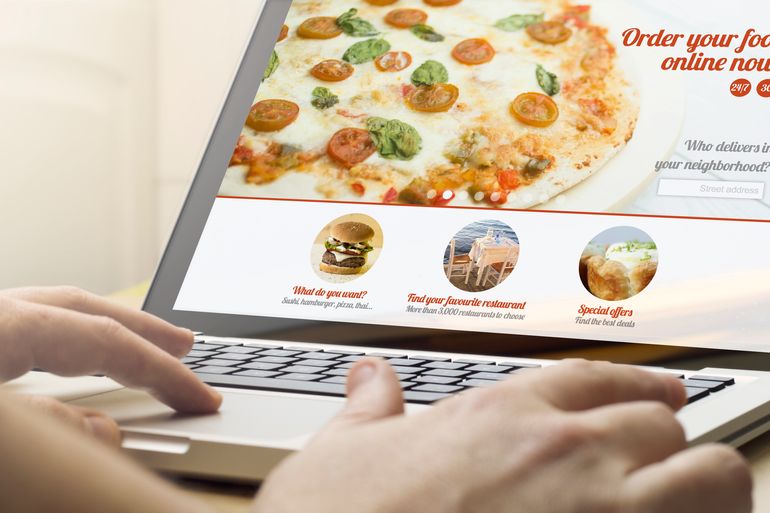
9) Communicate with Customers
Even if you’ve continued to offer takeout and delivery throughout the pandemic, regular communication is important to keep customers in the loop about any changes to your business – whether that’s reopening your dining room or simply extending your hours of operation.
If you’re not communicating regularly, many people may simply assume that your restaurant is closed.
As you plan your restaurant opening, make sure you communicate with customers on the following channels:
- Website: Address health and safety concerns by posting the steps you’re taking to mitigate the spread of COVID-19.
- Email: Drum up excitement for your reopening with an e-blast to your subscribers.
- Social Media: Use the visual nature of social media to showcase star menu items.
- Third-Party Platforms: Ensure your hours of operation and current menu are updated across all third-party apps, like Uber Eats and DoorDash.
10) Continuing Offering Takeout and Delivery
After months of relying on takeout and delivery, many diners have adapted to this new off-premise restaurant experience. These habits are unlikely to disappear overnight and some guests may continue to prefer dining at home for some time, even after restaurants have reopened their doors.
Restaurateurs need to prepare for the gradual transition from takeout-only to dine-in by maintaining some of the takeout and delivery systems that consumers have come to rely on.
While this doesn’t mean you have to continue delivering pantry staples and meal kits, it’s a good idea to have some takeout and delivery options for customers who are still wary of dining in.
After months of keeping your customers at arms-length, it’s tempting to want to throw open your doors and go back to normal. But with the threat of COVID-19 still lingering, it’s important to recognize that there’s no normal to go back to right now.
Things have changed dramatically for both restaurateurs and customers, so if you’re planning a restaurant opening in the near future, you’ll need to have a solid plan in place to prepare for this new reality.
Sign up for our free weekly TouchBistro Newsletter





